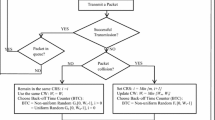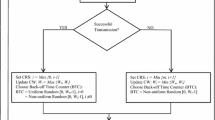Abstract
In this paper, we provide an extended model for analytical analysis of IEEE 802.11 wireless local area networks under noisy wireless channel. A reservation stage is introduced in the Markov chain model to reduce unnecessary retransmissions in the case of transmission failure due to channel error. A lot of work has been carried out to enhance the performance of 802.11 distributed coordination function in the error free channel. Throughput enhancement of 802.11 medium access control protocol under error prone channel was still missing in the available literature. Through the analysis result it is shown that the proposed method significantly improves the performance of the backoff algorithm when the reservation stage is employed in the Markov chain model. The analysis result is validated by using the network simulator tool ns-2. The proposed modifications can be employed in the Markov chain model of any backoff algorithm.
Similar content being viewed by others
References
Wireless LAN Medium Access Control (MAC) and Physical Layer (PHY) Specification, IEEE Std. 802.11, 1999.
Bianchi G. (2000) Performance analysis of the IEEE 802.11 distributed coordination function. IEEE Journal on Selected Areas of Communication 18: 535–547
Qiao D., Choi S., Shin K. G. (2002) Goodput analysis and link adaptation for IEEE 802.11a wireless LANs. IEEE Transactions on Mobile Computing 1: 278–292
Chatzimisios, P., & Boucouvalas, A. C. (2002). Throughput and delay analysis of the IEEE 802.11 protocol. In Proceedings of IEEE international workshop on network appliances, pp. 168–174.
Chatzimisios P., Boucouvalas A. C., Vitsas V. (2003) Influence of channel BER on IEEE 802.11 DCF. IEE Electronic Letters 39: 1687–1689
Latkoski, P., Hadi-velkov, Z., & Popovski, B. (2006). Extended model for performance analysis of nonsaturated IEEE 802.11 DCF in erroneous channel. In Proceedings of international conference on mobile Adhoc and sensor systems, pp. 783–788.
Samhat, A., Altman, Z., & Fourestie, B. (2006). Performance analysis of the IEEE 802.11 DCF with imperfect radio conditions. In Proceedings of international conference on wireless and mobile communications, pp. 27–31.
Choudhury S., Gibson J.D. (2008) Throughput optimization for wireless LAN in the presence of packet error rate constraints. IEEE Communications Letters 12: 11–13
Chatzimisios, P., Boucouvalas, A. C., & Vitsas, V. (2004). Performance analysis of IEEE 802.11 DCF in presence of transmission errors. In Proceedings of IEEE international conference on communication, pp. 3854–3858.
Daneshgaran F., Laddomada M., Mesiti F., Mondin M., Zanolo M. (2008) Saturation throughput analysis of IEEE 802.11 in presence of non ideal transmission channel and capture effects. IEEE Transactions on Communications 56: 1178–1188
Daneshgaran F., Laddomada M., Mesiti F., Mondin M. (2008) Unsaturated throughput analysis of IEEE 802.11 in presence of non ideal transmission channel and capture effects. IEEE Transactions on Wireless Communications 7: 1276–1286
Ni Q., Li T., Turletti T., Xiao Y. (2005) Saturation throughput analysis of error prone 802.11 wireless networks. Wireless Communications and Mobile Computing 5: 945–956
Ergen M., Varaiya P. (2005) Admission control and throughput analysis in IEEE 802.11. Mobile Networks and Applications 10: 705–716
Vishnevsky, V., & Lyakhov, A. (2002). 802.11 LANs: Saturation throughput in presence of noise. In Proceedings of networking conference, pp. 1008–1019.
Lyakhov A., Vishnevsky V. (2005) Comparative study of 802.11 DCF and its modification in the presence of noise. Wireless Networks 11: 729–740
Wu, H., Cheng, S., Peng, Y., long, K., & Ma, J. (2002). IEEE 802.11 distributed coordination function (DCF): Analysis and enhancement. In Proceedings of IEEE international conference on Communications, pp. 605–609.
Kwon, Y., Fang, Y., & Latchman, H. (2003). A novel MAC protocol with fast collision resolution for wireless LANs. In Proceedings of Infocom, pp. 853–862.
Qiao, D., & Shin, K.G. (2003). UMAV: A simple enhancement to the IEEE 802.11 DCF. In Proceedings of international conference on system sciences, pp. 9–14.
Zhang, Q., Sun, B., Gui, C., & Zeng, C. (2008). A new collision resolution mechanism for IEEE 802.11 WLAN. In Proceedings of international conference on computer communication and networks, pp. 1–6.
Xu, D., Sakurai, T., & Vu, H. L. (2008). An analysis of different backoff functions for an IEEE 802.11 WLAN. In Proceedings of IEEE vehicular technology conference, pp. 1–5.
Cali F., Conti M., Gregori E. (2000) IEEE 802.11 protocol: Design and performance evaluation of an adaptive backoff mechanism. IEEE Journal of Selected Areas of Communication 18: 1774–1786
Choi J., Yoo S., Choi S., Kim C. (2005) EBA: An enhancement of the IEEE 802.11 DCF via distributed reservation. IEEE Transactions on Mobile Computing 4: 378–390
Xian Y., Li F.H., Wu K., Leung K., Ni Q. (2006) On optimizing backoff counter reservation and classifying stations for the IEEE 802.11distributed wireless LANs. IEEE Transactions on Parallel and Distributed Systems 17: 713–722
Minooei H., Nojumi H. (2007) Performance evaluation of a new backoff method for IEEE 802.11. Computer Communications 30: 3698–3704
Malone D., Clifford P., Leith D. J. (2007) MAC layer channel quality measurement in 802.11. IEEE Communication Letters 11: 143–145
Pang Q., Leung V.C.M., Liew S. (2006) Improvement of WLAN contention resolution by loss differentiation. IEEE Transactions on Wireless Communications 5: 3605–3615
Pang Q., Liew S. C., Leung V. C. M. (2005) Design of an effective loss-distinguishable MAC protocol for 802.11 WLAN. IEEE Communication Letters 9: 781–783
Senthilkumar T. D., Krishnan A. (2010) Nonsaturation throughput enhancement of IEEE 802.11b distributed coordination function for heterogeneous traffic under noisy environment. International Journal of Automation and Computing 7: 95–104
Haykin S. (1988) Digital communications. Wiley, New York, pp 273–300
Proakis J. G. (2001) Digital communications. McGraw Hill, New York, pp 254–300
The network simulator-ns-2. [Online]. Available: http://www.isi.edu/nsnam/ns/, [Accessed January 26, 2010].
Author information
Authors and Affiliations
Corresponding author
Rights and permissions
About this article
Cite this article
Senthilkumar, D., Krishnan, A. Enhancement to IEEE 802.11 Distributed Coordination Function to Reduce Packet Retransmissions Under Imperfect Channel Conditions. Wireless Pers Commun 65, 929–953 (2012). https://doi.org/10.1007/s11277-011-0320-9
Published:
Issue Date:
DOI: https://doi.org/10.1007/s11277-011-0320-9




